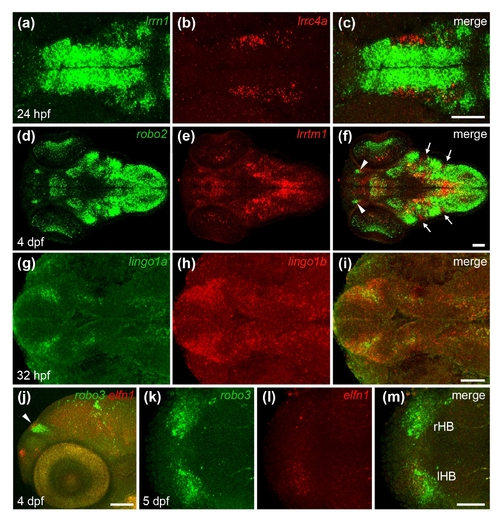
(a-c) Dorsal view of the zebrafish midbrain at 24 hours post-fertilization showing the nlrr1 gene (a) is expressed throughout the neuroepithelium of the midbrain, whereas its receptor, ngl2 (b), is restricted to two lateral midbrain domains that directly abut the nlrr1 expression domain (c). (d-f) A single optical section through the brain of a 4 days post-fertilization (dpf) zebrafish larva showing that robo2 (d) and lrrtm1 (e) are expressed in restricted patterns within all brain regions. The merge (f), shows largely non-overlapping, adjacent expression, particularly in a forebrain nucleus (arrowheads) and the hindbrain (arrows). (g-i) Dorsal view of the forebrain and partial midbrain of a 32 hours post-fertilization zebrafish larva showing that lingo1a (g) and lingo1b (h) are expressed in partially overlapping domains in the telencephalon (i). (j) Lateral view of a 4 dpf zebrafish larva showing robo3 expression in green and elfn1 expression in red. Both genes are expressed in the habenula nucleus in the dorsal forebrain (arrowhead). (k-m) Dorsal view of the forebrain region of a 5 dpf zebrafish larva showing that robo3 is expressed symmetrically in both habenula nuclei (k), whereas elfn1 (l,m) is expressed asymmetrically with higher expression levels in the left nucleus (lHB). All images are two-color wholemount in situ hybridizations with anterior left; cartoons depicting the interacting receptor-ligand pairs are shown in the left panels. Scale bar: 50 μm (a-c,d-f,g-j,k-m); 93 μm (j).
|

